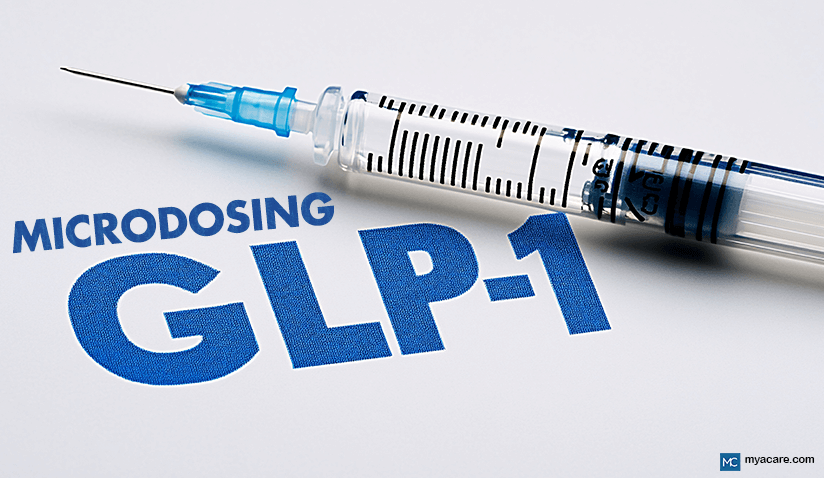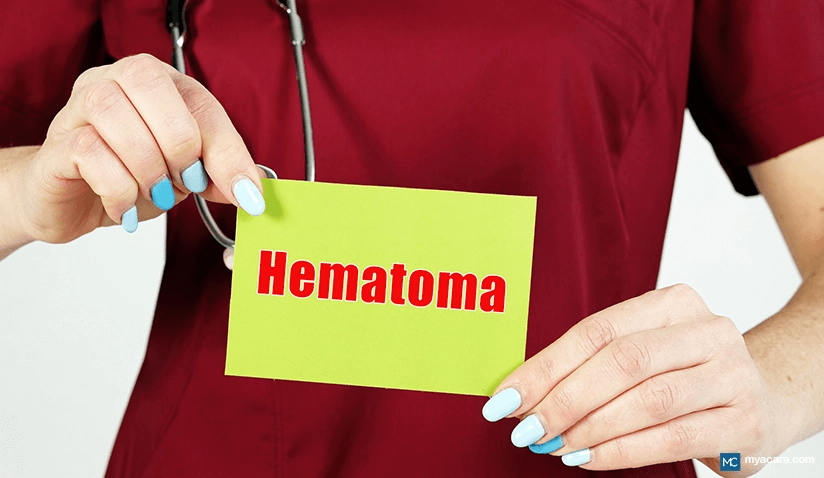Microdosing GLP-1 Drugs: Potential Benefits, Risks, and the Evidence Gap

Medically Reviewed by Dr. Sony Sherpa, (MBBS)
GLP-1 agonist medications, such as Ozempic and Wegovy, are gaining widespread attention for their effectiveness in managing type 2 diabetes and supporting weight reduction. These medications, primarily prescribed in standard dosages, have transformed how individuals manage their health conditions.
Recently, however, there has been a growing trend of "microdosing" GLP-1s, a practice that involves using smaller-than-prescribed doses of these drugs. This article explores the emerging trend of microdosing GLP-1 drugs, examining potential benefits, risks, and the current lack of scientific evidence supporting this approach.
Mechanism of Action
GLP-1 is a native hormone secreted by the intestines in response to food intake. It acts on multiple organs, including the pancreas, brain, and stomach. When administered as a medication, GLP-1 receptor agonists effectively mimic the action of the naturally occurring hormone, leading to several beneficial physiological effects.
- Increased Insulin Secretion: GLP-1 receptor agonists promote insulin secretion in a glucose-dependent manner, stimulating the pancreas to release insulin primarily when blood glucose levels are elevated. This mechanism supports effective blood sugar regulation while minimizing the risk of hypoglycemia.
- Inhibition of Glucagon Release: GLP-1 helps regulate blood sugar by inhibiting glucagon, a hormone that triggers the liver to release stored glucose, which can raise blood sugar levels. By inhibiting glucagon production, GLP-1 receptor agonists help maintain lower blood glucose levels, preventing unwanted spikes.
- Slowed Gastric Emptying: One of the significant effects of GLP-1 receptor agonists is the delay in the movement of food from the stomach into the intestines. This action helps to prolong the feeling of fullness after eating, which not only aids in appetite control but also contributes to weight loss by reducing overall calorie intake.
- Appetite Regulation: GLP-1 receptor agonists influence the brain’s appetite centers, leading to a reduction in hunger and cravings. This makes it easier for individuals to stick to healthier eating patterns, thus contributing to weight loss over time.
Commonly Prescribed GLP-1 Medications
Two of the most widely prescribed GLP-1 receptor agonists are Ozempic and Wegovy. Both of these medications contain semaglutide, a synthetic version of the GLP-1 hormone, but they are prescribed at different doses depending on the patient’s medical needs.
- Ozempic: Ozempic is typically prescribed for the management of type 2 diabetes. It helps patients with diabetes manage their blood sugar more effectively and lowers their risk of heart attack and stroke. Ozempic is usually administered once a week via subcutaneous injection.
- Wegovy: On the other hand, Wegovy is prescribed primarily for weight loss. Containing a higher quantity of semaglutide, this medication is indicated for people with obesity or those who are overweight and have a co-existing condition such as high blood pressure or type 2 diabetes. Like Ozempic, Wegovy is administered once a week through an injection.
Proven Benefits of GLP-1 Receptor Agonists
The mechanism by which GLP-1 receptor agonists such as Ozempic and Wegovy work, as described above, facilitates the following benefits:
- Blood Sugar Control: GLP-1 receptor agonists, like Ozempic, effectively lower blood sugar by enhancing insulin sensitivity, boosting insulin release, and decreasing liver glucose production. This aids in achieving better blood sugar control for people with type 2 diabetes, helping them reduce their susceptibility to complications like nerve damage, kidney disease, and eye problems.
- Weight Loss: A highly desired benefit of GLP-1 receptor agonists, such as Wegovy, is their effectiveness in promoting weight loss. Studies indicate that patients on Wegovy often achieve significant weight loss, frequently exceeding 10% of their body weight. This makes it an appealing option for individuals struggling with obesity or those requiring weight reduction for health reasons.
- Cardiovascular Benefits: Both Ozempic and Wegovy have been shown to have positive effects on heart health. They can lower the risk of major cardiovascular events such as heart attack, stroke, and cardiovascular death, especially in individuals with type 2 diabetes who are at higher risk for these conditions.
- Improved Blood Pressure and Cholesterol Levels: In addition to their effects on blood glucose and weight, GLP-1 receptor agonists also contribute to improvements in blood pressure and lipid profiles, which can further reduce the risk of cardiovascular disease.
Standard GLP-1 Dosing: What's Established
Typical Doses
The prescribed doses of GLP-1 receptor agonists are based on extensive clinical research and established therapeutic guidelines. Ozempic, for example, is typically initiated at a dose of 0.25 mg once a week, with gradual escalations to 0.5 mg, 1 mg, and up to 2 mg, depending on the patient's response and tolerance. Wegovy, on the other hand, starts at a lower dose but eventually reaches 2.4 mg per week for weight management.
The Importance of Medical Supervision and Prescribed Dosing
Following prescribed dosages is vital for patients using GLP-1 receptor agonists. The pharmacokinetics of these drugs, including their absorption, distribution, metabolism, and elimination, are carefully designed to ensure optimal receptor saturation and therapeutic effect. Deviating from the prescribed dosage could result in suboptimal outcomes or increased risks of adverse effects.
Self-experimentation with drug dosages, such as microdosing, should be avoided. Medical supervision ensures that patients receive the correct dosage tailored to their individual health needs, minimizing the risk of complications. Therefore, any deviation from the prescribed regimen should only be done under the guidance of a healthcare professional.
Microdosing GLP-1 Drugs
What is Microdosing?
Microdosing refers to the practice of using a dose smaller than the standard prescription. The idea behind microdosing is to achieve some of the benefits of the drug, such as weight loss or blood sugar control, while minimizing side effects like gastrointestinal discomfort, which is commonly reported with full doses.
Microdosing GLP-1 drugs often involves using an adjustable auto-injector pen, which allows patients to fine-tune their dose to smaller amounts. For example, someone using Ozempic may adjust their weekly dosage to a fraction of the standard 0.5 mg or 1 mg dose. However, this approach lacks official recommendations and has not undergone thorough clinical testing to ensure its safety and effectiveness.
Microdosing Schedules or Charts
While there is no official guideline or approved schedule for microdosing GLP-1s, some individuals have resorted to creating informal charts or schedules to guide their self-administered doses. These schedules often recommend initiating treatment with a very low dose and progressively increasing it, depending on the individual’s tolerance to side effects. However, this is a form of self-medication, which is risky without professional oversight.
In certain cases, healthcare providers may recommend microdosing GLP-1 drugs as part of a personalized treatment plan, particularly for patients with underlying gastrointestinal issues. For example, some diabetic patients who experience gastrointestinal side effects from standard doses of GLP-1 receptor agonists may benefit from a slower dose escalation to reduce discomfort.
This approach would typically involve close monitoring by a healthcare provider to ensure that the lower doses are still effective in managing blood sugar and that the patient remains safe from potential side effects. However, this practice is not widespread and is still considered an off-label use of the drug.
Purported Benefits of Microdosing GLP-1s
From the User's Perspective
There are several reasons why individuals might choose to microdose GLP-1 drugs, including minimizing side effects, reducing costs, and achieving gradual weight loss.
- Minimizing Side Effects
One of the most frequently cited reasons for microdosing GLP-1 drugs, as mentioned above, is the desire to minimize side effects. Full doses of these medications can cause gastrointestinal issues, such as nausea, vomiting, and diarrhea. By microdosing, patients may reduce the intensity of these side effects while still experiencing some therapeutic benefits.
- Cost Concerns
The high cost of GLP-1 drugs, especially for weight loss purposes, is another driving factor behind the microdosing trend. Some individuals may turn to smaller doses to reduce their overall medication costs. Insurance coverage for weight loss drugs can be limited, leading to financial strain for patients seeking the benefits of these medications.
- Gradual Weight Loss and Muscle Maintenance
For those using GLP-1 drugs primarily for weight loss, microdosing might offer a more gradual weight loss experience, which some individuals believe helps preserve muscle mass. Rapid weight loss can contribute to muscle loss, whereas a slower reduction in body fat may help preserve lean muscle mass.
- Off-label Use for Cosmetic Weight Loss
While GLP-1 drugs are FDA-approved for treating type 2 diabetes and obesity, they are often used off-label by individuals seeking weight loss without a diagnosed condition.
- Compensating for Supply Issues
Due to increasing demand for GLP-1 drugs, there have been occasional shortages in the supply of medications like Ozempic and Wegovy. Microdosing may offer an unofficial solution to stretch the supply of these drugs further, allowing patients to continue their treatments while waiting for new shipments to arrive.
Safety: Possible Risks and Side Effects
Is Microdosing Semaglutide Safe?
The safety of microdosing semaglutide (the active ingredient in Ozempic and Wegovy) remains a subject of debate. While proponents claim that using lower doses can reduce side effects, there is a lack of scientific evidence to support this. Microdosing these medications may carry several potential risks, including reduced efficacy and unforeseen side effects.
Potential Downsides of Microdosing
- Reduced Efficacy
One of the primary concerns with microdosing GLP-1 drugs is that lower doses may not provide the desired therapeutic effects. GLP-1 drugs are designed to work at certain doses to achieve optimal receptor saturation. By microdosing, individuals may not reach the necessary level of the drug in their system to effectively manage blood sugar or promote significant weight loss.
- Unforeseen Side Effects
While microdosing may reduce some side effects, it could also lead to new or unexpected reactions. Due to the limited research on microdosing, the body's long-term response to these reduced doses remains unpredictable.
- Risk of Overdose and Contamination
Self-administering smaller doses carries the risk of overdose if a patient miscalculates or adjusts the dose incorrectly. As these drugs are intended for specific dosages, using them improperly may lead to contamination or spoilage.
Conclusion
The trend of microdosing GLP-1 drugs like Ozempic and Wegovy has gained attention due to its potential for minimizing side effects, lowering costs, and promoting gradual weight loss. However, the practice lacks sufficient scientific backing and is fraught with risks, including reduced efficacy, unforeseen side effects, and the possibility of drug contamination or misuse.
While microdosing might seem appealing, sticking to prescribed dosages and consulting a healthcare provider before making any adjustments is important. The absence of strong clinical evidence validating the safety of microdosing underscores the importance of cautious, evidence-based approaches to medication management.
To search for the best doctors and healthcare providers worldwide, please use the Mya Care search engine.
The Mya Care Editorial Team comprises medical doctors and qualified professionals with a background in healthcare, dedicated to delivering trustworthy, evidence-based health content.
Our team draws on authoritative sources, including systematic reviews published in top-tier medical journals, the latest academic and professional books by renowned experts, and official guidelines from authoritative global health organizations. This rigorous process ensures every article reflects current medical standards and is regularly updated to include the latest healthcare insights.

Dr. Sony Sherpa completed her MBBS at Guangzhou Medical University, China. She is a resident doctor, researcher, and medical writer who believes in the importance of accessible, quality healthcare for everyone. Her work in the healthcare field is focused on improving the well-being of individuals and communities, ensuring they receive the necessary care and support for a healthy and fulfilling life.
References:
Featured Blogs



